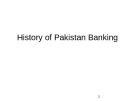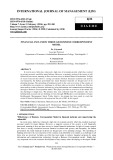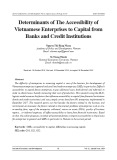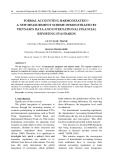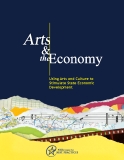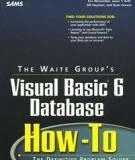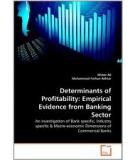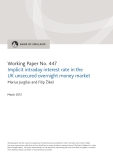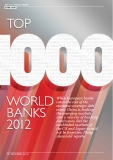
Formalizing Banking
-
This book is highly recommended to not only financial/economic historians, but also readers who are currently or will in the future be involved in banking supervision, that is, students, bankers, supervisors, and international officials.
 173p
173p  minhquan0690
minhquan0690
 19-09-2023
19-09-2023
 5
5
 3
3
 Download
Download
-
The observation of firms’ political connections (PCs) and corruption has raised the question of their benefits to firms’ operation, especially on accessing to the financial resources. Firms with stronger political connections or informal payment willingness may get easier in approaching to formal bank loans. The paper gives a better understanding about the characteristics of SMEs in an emerging market and a networkoriented country like Vietnam.
 5p
5p  visirius
visirius
 11-01-2023
11-01-2023
 10
10
 4
4
 Download
Download
-
Banking in Pakistan first formally started in Pakistan during the period of British colonialism in the South Asia. After independence from British Raj in 1947, and the emergence of Pakistan as a country in the globe, the scope of banking in Pakistan has been increasing and expanding continuously.
 27p
27p  nanhankhuoctai10
nanhankhuoctai10
 23-07-2020
23-07-2020
 8
8
 1
1
 Download
Download
-
This paper provides an overview of the model and the challenges it might face. The primary data were collected from 55 customers who were holding bank account and use banking services through SBI Business correspondents in Iyyan Reddiyapatti, Marungapuri block, Trichy district.
 6p
6p  murielnguyen
murielnguyen
 29-06-2020
29-06-2020
 28
28
 1
1
 Download
Download
-
This study examines how financial literacy and financial innovation can improve financial inclusion among households in Uganda. Large sections of the population in rural and urban areas in Uganda still remain out of the coverage of formal financial systems. The study uses a cross sectional survey research design. The study population comprised of the adult population in both rural and urban settings in Uganda. Empirical data was analyzed using correlation and regression analyses.
 20p
20p  trinhthamhodang2
trinhthamhodang2
 19-01-2020
19-01-2020
 20
20
 4
4
 Download
Download
-
The difficulty of enterprises in accessing capital is one of the barriers for development of Vietnamese enterprises in general and small and medium enterprises (SMEs) in particular. Difficult accessibility to capital forces enterprises to pay additional costs (both formal and informal) in order to obtain loans, thereby increasing their cost of production.
 15p
15p  viartemis2711
viartemis2711
 22-10-2019
22-10-2019
 39
39
 1
1
 Download
Download
-
This paper contends the data specifically used to evaluate accounting measurement issues. The data will be divided into initial and subsequent recognition because such partition collectively affects the financial report figures.
 13p
13p  vititan2711
vititan2711
 14-08-2019
14-08-2019
 26
26
 0
0
 Download
Download
-
Good availability of bank credit and informal capital can partially but not fully substitute for underdeveloped equity markets. New Zealand’s banking sector has been growing since 1990 in line with growth in Australia and Denmark. Informal capital markets are also larger than in most OECD countries relative to GDP. International Linkages While New Zealand’s economy has low formal barriers to trade, its share of external trade (relative to GDP) is well below that of similar-sized, high-performing OECD countries.
 44p
44p  trinhcaidat
trinhcaidat
 19-04-2013
19-04-2013
 53
53
 6
6
 Download
Download
-
The self-reported barriers vary significantly across regions as well as by individual characteristics. Among adults without a formal account, those in Sub-Saharan Africa and Latin America and the Caribbean are the most likely to cite missing documentation as a reason for not having one. Those in Europe and Central Asia have the least trust in banks. Women tend to report using someone else’s account significantly more than do men, highlighting the challenges that women may encounter in account ownership.
 703p
703p  nhacsihuytuan
nhacsihuytuan
 13-04-2013
13-04-2013
 76
76
 11
11
 Download
Download
-
In this mechanistic and formal trend we could also include what is known as contingency theory, which, according to Amat (1991), is a simplification of systems theory. This approach maintains that no control system is ideal for all organisations, but instead depends on the circumstances in which it finds itself (Amat, 1991). It is thought to have been developed by Burns and Stalker (1961), Thomson (1967), Woodward (1965), Lawrence and Lorsch (1967), and Gordon and Miller (1975).
 13p
13p  nhacchovina
nhacchovina
 25-02-2013
25-02-2013
 38
38
 2
2
 Download
Download
-
The purpose of the Companion is to provide a reference work for the active researcher in law and economics. In so doing, care has been taken to avoid a possible overlap with other works in the field. In particular, the Companion does not intend to duplicate the ambitious New Palgrave, which aims to balance its pointedly formal focus by emphasizing institutional economics (Newman, 1998).
 777p
777p  phoebe75
phoebe75
 20-02-2013
20-02-2013
 51
51
 7
7
 Download
Download
-
The first set of indicators focuses on formal accounts; the mechanics of the use of these accounts ( frequency of use, mode of access); the purpose of these accounts (personal or business, receipt of payments from work, government, or family); barriers to account use; and alternatives to formal accounts (mobile money). The account penetration indicator measures individual or joint ownership of formal accounts—accounts at a formal financial institution such as a bank, credit union, co- operative, post office, or microfinance institution.
 9p
9p  mebachano
mebachano
 01-02-2013
01-02-2013
 34
34
 2
2
 Download
Download
-
These differences are likely to stem from three important variations in user-side data on the use of financial services. First, the definition of an account varies across surveys and respondents are often prompted in different ways. The Global Findex survey defines an account as an individual or joint account at a formal financial institution (a bank, credit union, cooperative, post office, or microfi- nance institution) and notes in the question text that an account can be used to save money, to make or receive payments, or to receive wages and remittances.
 9p
9p  mebachano
mebachano
 01-02-2013
01-02-2013
 41
41
 2
2
 Download
Download
-
Nevertheless, a cursory look at these self-reported barriers provides interesting information. Distance from a bank is a much greater barrier in rural areas, as expected. Technological and other innovations that help overcome this barrier of physical distance could pay off—potentially increasing the share of adults us- ing a formal account by up to 23 percentage points in Sub-Saharan Africa and 14 percentage points in South Asia.
 25p
25p  mebachano
mebachano
 01-02-2013
01-02-2013
 79
79
 5
5
 Download
Download
-
Worldwide, by far the most common reason for not having a formal account— cited by 65 percent of adults without an account—is lack of enough money to use one. This speaks to the fact that having a formal account is not costless in most parts of the world and may be viewed as unnecessary by a person whose income stream is small or irregular. Other common reasons reported for not having an account are that banks or accounts are too expensive (cited by 25 percent of adults without a formal account) and that banks are too far away (cited by 20...
 61p
61p  mebachano
mebachano
 01-02-2013
01-02-2013
 40
40
 5
5
 Download
Download
-
Unique data on the mechanics of account use across economies show that here too there are sharp differences between high-income and developing economies—in the frequency of deposits and withdrawals, in the way that people access their ac- counts, and in the payment systems they use. In developing economies 10 percent of adults with a formal account report making no deposits or withdrawals in a typical month; in high-income economies only 2 percent report this.
 81p
81p  mebachano
mebachano
 01-02-2013
01-02-2013
 45
45
 5
5
 Download
Download
-
Deposits - Policies may be “bound”, or formally agreed to, before all the details are worked out. This can result in a “binder” premium, or initial deposit. Policies can also be sold for which the pricing exposure is not initially known, also requiring an initial deposit premium until an estimate of the ultimate premium can be obtained. (Deposit premiums are sometimes used for reinsurance treaties where the final premium is a function of the subject business during the treaty effective period.
 23p
23p  taisaovanchuavo
taisaovanchuavo
 26-01-2013
26-01-2013
 59
59
 3
3
 Download
Download
-
These banking successes should be celebrated. They pave the way for broadening access to finance for hundreds of millions, perhaps even billions, of low-income people who today lack ready access to formal financial services. Such access on its own is not yet proven to increase economic growth or to reduce poverty on a large-scale level—and, as a general proposition, we doubt that it will on its own.
 32p
32p  taisaovanchuavo
taisaovanchuavo
 23-01-2013
23-01-2013
 74
74
 5
5
 Download
Download
-
The competing reactions reveal diverging views around the possibilities and limits of microfinance, a polarization captured colorfully by Connie Bruck (2006) in The New Yorker. Yet there are also areas of shared vision. Most important, all agree that the demand for reliable financial services is huge. We estimate that roughly 40 to 80 percent of the populations in most developing economies lack access to formal sector banking services (Beck, Demirguc-Kunt and Martinez Peria, 2007; World Bank, 2007).
 0p
0p  taisaovanchuavo
taisaovanchuavo
 23-01-2013
23-01-2013
 45
45
 4
4
 Download
Download
-
The limited access to finance remains a key constraint on growth across the region, limiting the scope for smaller, less well-established firms to finance investment through the formal banking system. How to improve access and increase the level of financial intermediation remains a key policy challenge.
 9p
9p  machuavo
machuavo
 19-01-2013
19-01-2013
 41
41
 4
4
 Download
Download
CHỦ ĐỀ BẠN MUỐN TÌM











